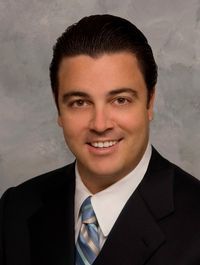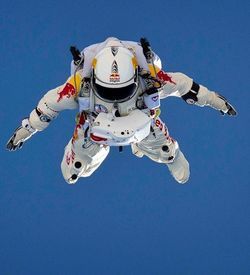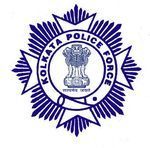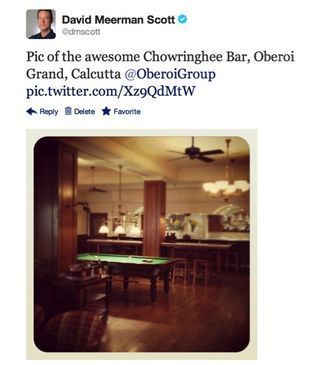David Meerman Scott's Blog, page 80
October 24, 2012
Professional Services Firm Grows 50% through Switch from Outbound to Inbound Marketing
 I recently had several lengthy discussions with my friend Greg Alexander, CEO of Sales Benchmark Index to learn how he made the switch from traditional outbound marketing like cold calls to a content-driven marketing approach using blogs, twitter, ebooks, and videos. The strategy has grown Greg's revenue 50% in the past year. Sales Benchmark Index has grown from a very small firm 6 years ago to a firm with dozens of consultants today.
I recently had several lengthy discussions with my friend Greg Alexander, CEO of Sales Benchmark Index to learn how he made the switch from traditional outbound marketing like cold calls to a content-driven marketing approach using blogs, twitter, ebooks, and videos. The strategy has grown Greg's revenue 50% in the past year. Sales Benchmark Index has grown from a very small firm 6 years ago to a firm with dozens of consultants today.
The wide ranging discussion was so chock full of valuable information I want to share with you, that I've decided to make it a series of three blog posts starting today and running tomorrow and the next day.
Sales Benchmark Index is a professional services firm, focused exclusively on B2B sales force effectiveness. Sales Benchmark Index helps large and small clients gain a competitive advantage through the way they engage with their clients, the sales process, and the effectiveness of their sales force so they make sales numbers faster and with less effort.
This is a particularly fascinating example of success because Greg's business – the services his company offers – is completely metrics driven. And that's how Greg markets and sells too, based on the metrics, so this is a case study chock full of ROI measurements!
Outbound Marketing stopped working
Prior to making the switch to Inbound Marketing, Sales Benchmark Index deployed classic outbound activity. "We hired telemarketing firms to cold call," Greg says. "We did batch and blast email. We did interruption-based marketing tactics of all kinds and for a period of time from 2006 to 2010, that approach met our needs. And our needs are really well defined: We know how many inquiries we need to generate all the way through to paying customers. Then early, the effectiveness of the outbound channels just stopped. It's like somebody slammed the doors shut."
Greg thinks that his outbound strategies stopped working because his target audience was super busy. "I wasn't competing against other companies," he says. "I was competing for buyers' attention."
How buyers solve problems
Greg has done a great deal of research on how his buyer personas solve problems. And that was the starting point of his efforts to switch to Inbound Marketing.
"When our target customer (the head of sales or the head of marketing in a B2B organization) has a problem or need in their business, the very first thing they do – and we've done a lot of research to support this – is start searching the Web and reading and educating themselves," Greg says. "They typically don't want to engage with a service provider, us or anybody else for that matter, for a long time. Through education on the Web, they develop a crisp, well-articulated problem statement. Then they reach out to a small number of people to ask for their assistance in how they might approach solving that problem. It's similar to the way somebody would hire a law firm or a strategy consulting firm or an advertising agency."
Building buyer persona profiles and buyer process maps
Once Greg and his team understood how buyers solved problems, the next step was to develop buyer persona profiles and buyer process maps.
"We wanted to understand the key business objectives of each target audience," Greg says "What was standing in the way of them accomplishing those objectives? What were the things that were important to them when they made a decision to hire a service provider? How were they measured? What would the definition of success be? Once we understood that, we mapped the buying process for each persona. We identified when information requests were happening in the buying process for example, and what those information requests were."
Greg quickly realized that he had to create a lot of new content assets so he chose to create what he calls an "internal content marketing agency."
I love the approach Greg has taken to building content. Since Sales Benchmark Index is a professional services firm with smart subject experts, they needed to create an environment to channel the expertise into the creation of blog posts, videos, and longer form content assets like ebooks.
I'll talk in detail about how his team creates content in tomorrow's post. Then on Friday. I'll discuss how Greg measures success and provide his advice to other CEOs on how to get started with a inbound marketing content strategy.
Disclosure: Greg and I serve together on the Eloqua board of advisors, which is where we met.
October 19, 2012
Facebookjacking: When a company does not respond others win
Here's a fun Friday story that comes to us via Mark Copeman.
 A 26-year-old named Thomas Cook posted a lighthearted message on the Thomas Cook UK Facebook page: "Seeing as I share the exact same name as your huge company, and because of this I have been ridiculed for as long as I can remember, I think it's only fair that you help compensate for this by giving me one of your lovely holidays."
A 26-year-old named Thomas Cook posted a lighthearted message on the Thomas Cook UK Facebook page: "Seeing as I share the exact same name as your huge company, and because of this I have been ridiculed for as long as I can remember, I think it's only fair that you help compensate for this by giving me one of your lovely holidays."
When the big, famous travel agency (143,000+ Facebook likes) replied back to say "no" to the request, quick-thinking competitor lowcostholidays.com (81,000+ likes) jumped in to offer Thomas Cook (the person) a free trip to Paris.
 "Here at lowcostholidays.com we completely sympathise with your suffering and if your name was “lowcostholidays.com” we would certainly have accepted your request to be sent away on a weekend in Paris,” Charlotte Hunt from lowcostholidays.com wrote. "...So how about we send you on that weekend in Paris?"
"Here at lowcostholidays.com we completely sympathise with your suffering and if your name was “lowcostholidays.com” we would certainly have accepted your request to be sent away on a weekend in Paris,” Charlotte Hunt from lowcostholidays.com wrote. "...So how about we send you on that weekend in Paris?"
Thomas Cook (the person) took up lowcostholidays.com on the offer and then posted his experience. Media outlets in the UK including the Mirror within the past 24 hours.
lowcostholidays.com has cleverly kept the meme alive with additional Facebook posts like After all this talk about Paris we thought we’d tell you a little more about why this city is so great...
Shall we call this Facebookjacking?
 What Thomas Cook (the person) did was have some lighthearted fun on the Thomas Cook UK (travel company) Facebook page. In my opinion it was not a "demand" but just a way to poke some fun. Thomas Cook UK responded (which is good, they could have ignored it), but they failed to see the social media potential of the situation.
What Thomas Cook (the person) did was have some lighthearted fun on the Thomas Cook UK (travel company) Facebook page. In my opinion it was not a "demand" but just a way to poke some fun. Thomas Cook UK responded (which is good, they could have ignored it), but they failed to see the social media potential of the situation.
Kudos to lowcostholidays.com for monitoring the competitor's Facebook page and jumping in to seize the opportunity, thereby controlling the emerging meme. Maybe this should be called Facebookjacking?
When to respond. How to respond.
The challenge for companies in this new world is to figure out when to respond (and when to ignore). The number of people who request (or demand) stuff from you will increase as these sorts of stories go viral.
The basic rule to consider: Is this request thoughtful? How can we benefit from this? Or is the person making the request a bully or someone just out to score free goods or services?
If the person is thoughtful, they deserve a response.
But remember, you don’t always have to give someone exactly what they want. Thomas Cook UK could have sympathized with the person who shared a name with them and offered something else (even just a T-shirt) because that would show they cared.
When Dave Carroll posted United Breaks Guitars, United rightly didn't offer compensation (that would have opened up opportunities for thousands of people to demand similar treatment). But United missed a huge opportunity because they did not respond at all. Had they, for example, created their own video response (perhaps highlighting how bags are handled at O’Hare) they would have been seen as human and shared in Dave Carroll's triumph rather than being seen as the bad guys.
So if a situation like this happens to you, consider the request. Is it thoughtful? If so, respond! But respond with something equally clever.
Images via Imgur
October 18, 2012
Going off script
In most markets, there is a best practices playbook that people know is the "right way" to do marketing. There is an accepted script that people know and follow and most treat that script as if it were law and there is no other way to work.
For example, technology company Venture Capitalists have long insisted that the companies they fund invest in a monthly retainer for a traditional public relations agency.
Rock bands have long focused on the major-label record deal as the goal to reach.
I've found as I travel the world that the best successes frequently come from going off script. Those marketers who improvise - coming up with something new and interesting that the competitors aren’t doing - get noticed and build business.
Yet, the business world rewards the safe approach. CMOs are encouraged to stay on script. People and companies are afraid of veering from the "best practices" script.
Going off script
Rather than following the traditional VC playbook, since 2007 HubSpot has created tons of original content, publishing it on the web to market their products and services. As a result they have built an entire industry around the idea of Inbound Marketing and has grown very quickly as a result. Interestingly, the HubSpot model has become a new script for the nearly 10,000 customers that follow their advice.
Amanda Palmer fired her record label. Rather than following the traditional rock star script, she self-funded her latest album via Kickstarter and the buzz she generated put the album on the top ten Billboard album list upon release.
What conventional wisdom that "everybody knows" can you challenge? How can you go off script?
Here are a few truths people use as part of their playbooks you might consider challenging. I'm sure you can think of others.
"Facebook is for personal connections and LinkedIn for business."
"Older people are not on the Web and seniors don't use social media."
"You can’t reach physicians with online marketing."
"Because of strict regulations, the pharmaceutical, healthcare, and financial services industries cannot use social media."
"PR is about pitching journalists."
"The press release is dead."
"Newspapers are dying."
What conventional wisdom that "everybody knows" can you challenge? How can you go off script?
Disclosure: I am on the board of advisors and am Marketer in Residence at HubSpot.
October 14, 2012
Witnessing a real-time record-breaking social media spectacle
In July 1969 the world came together to watch a grainy black and white image on television of Neil Armstrong and Buzz Aldrin taking mankind's first steps on the moon. But those who watched the Apollo 11 mission were confined to their living rooms.
 This afternoon, the online world came together to witness Felix Baumgartner break multiple aerospace records in his Red Bull Stratos mission. And we shared it with each other in real-time.
This afternoon, the online world came together to witness Felix Baumgartner break multiple aerospace records in his Red Bull Stratos mission. And we shared it with each other in real-time.
Baumgartner traveled higher in a balloon than anyone – more than 127,800 ft. – and from that height he made the highest skydive, breaking a previous record that had stood for more than 50 years. While in free fall, he traveled Mach 1.24 — 833.9 miles per hour - making him the first human to travel faster than the speed of sound without being inside a craft.
It was riveting to witness – a real-time spectacle live on the web in HD that we could share via social networks.
A YouTube record
Another record was broken when it was reported that more than 8 million people watched a livestream of the record-breaking attempt.
I learned about the impending jump on, where else, Twitter. When I started to watch the balloon was at about 40,000 feet so I tweeted to my followers and posted on Facebook. Millions of others did the same.
It was great to watch the live stream and also keep an eye on the twitter stream. I was emailing friends in real-time. I texted my daughter when the jump was about to happen and she texted back that she was already watching. My wife Yukari Watanabe Scott was tweeting live with many of her friends in Japan.
Witnessing history. Together.
The online community came together for an hour to witness history. I don't recall anything like it. Everyone was positively giddy. For an hour we came together over one breathtaking event.
The real-time component was magnified because the team had attempted the jump several other times. Todays attempt was delayed for a few hours. So nobody knew if and when it might happen.
Unlike an Olympic event, there was no preparing. Suddenly it was on and we were compelled to watch. We told each other via social networks. Tens of millions of us alerted each other.
That the jump happened on a Sunday (it was mid-afternoon USA Eastern time) made it easy for many people to watch live.
The jump was audacious. It was incredibly visual. It was unfolding in real-time. And we could watch it together while commenting on social networks. It was one of those "I'll always remember where I was" moments.
Today we saw some incredible records broken.
And we also saw the future of how we will witness real-time events.
Image credit: Red Bull Stratos
October 12, 2012
When crappy interruption marketing harms a brand
Just because you have my email addresses, it doesn't mean you should email me your marketing message.
Just because you have my phone numbers, it doesn't mean you should call me with your sales pitch.
Just because we're connected on LinkedIn, it doesn't mean you can add me to your email list.
Just because I follow you on Twitter, it doesn't mean you can try to sell me something via Direct Message.
Intrusive, interruption-based marketing techniques frequently do much more harm than good. The creation of a "campaign" can piss people off so badly, that it can actually cause business to fall. It would have been better to do nothing.
Scott Brown's Intrusive Robocalls Will Hand Massachusetts US Senate Seat to Elizabeth Warren
I just published a piece in Huffington Post Scott Brown's Intrusive Robocalls Will Hand Election to Elizabeth Warren. I talk about how Warren will win the US Senate race in Massachusetts because voters like me are fed up with being interrupted at home by robocalls pimping Brown. At my home number, we've received quite a few recorded ads from Brown support groups including the Massachusetts Republican Party. So far, we have received no calls from Warren support groups.
The idea of spending money on annoying people seems like a good idea to traditional marketers. They buy a list, prepare a script, and reach out to "prospects".
Are these robocalls interruptions supposed to good? It just pisses me off. And I'm not the only one. Other Massachusetts residents I speak with are also fed up.
People hate sales calls. Some three quarters of Americans have signed up for the National Do Not Call Registry which does not currently apply to political organizations. This is something Shaun Dakin is fighting to change with his 300,000 person strong National Political Do Not Contact Registry.
If three quarters of Americans signed up to say "no" to sales calls, why the heck would a campaign think making a sales call is a good thing?
Crappy marketing
I see examples of this behavior all the time. Today I was added to an email list that I have no interest in. The person said, "Hello David Meerman. Since we're connected on LinkedIn I thought I'd let you know..." Bang! We are not connected anymore, pal. And hey, you don't even know my name. You blew it by interrupting me with an unwanted message.
If someone sends me an unwanted sales pitch via Twitter Direct Message, I immediately unfollow. Gone, Buh Bye.
Just because you've got passengers confined in a metal tube for a few hours on a plane, doesn’t mean USAir should wake me up from a nap to pimp their damned credit cards.
I don't go to my local mall food court as much as I used to because the owner, Simon Property Group installed a television system that loudly advertises stuff to everyone as they are seated and trying to eat.
You don't have permission
Marketers need to understand that ownership of an email address or phone number or being followed on Twitter is not permission to intrude with a sales message. This behavior does more harm than good. You’d be better off doing nothing.
Note: This is a marketing blog, not a political blog. I am commenting on Scott Brown’s marketing (or rather that of groups affiliated with him), not about the candidate himself.
October 10, 2012
NBC Digital scraps Madison Ave demographics in favor of personas
 Douglas Burdett points us to a fascinating story in the Media Post NBC News Kills The Demographic, Personifies Its Viewers Instead written by Joe Mandese.
Douglas Burdett points us to a fascinating story in the Media Post NBC News Kills The Demographic, Personifies Its Viewers Instead written by Joe Mandese.
The Media Post piece talks about how NBC News Digital is abandoning the traditional Madison Avenue demographics approach that has been used for decades that uses attributes like age, income, race, sex, and other factors to cluster audiences. This demographic approach is how advertising space has been bought and sold for a generation.
The new buyer persona approach on is based on their actual behaviors rather than a list of attributes.
The Media Post article lists the four personas used by NBC Digital as:
"Always On:" Consumers who are constantly connected to news feeds across multiple devices throughout their waking day.
"Reporters:" A slightly smaller segment of "digital natives" who grew up consuming news via online and mobile media, and who have manifested the behaviors of news disseminators, taking pride in their ability to break important news to their friends via their own social media postings.
"Skimmers:" Consumers who are not passionately connected to news.
"Veterans:" Consumers who primarily rely on traditional media as a trusted source for news.
NBC Digital is using the personas both to develop new content and to pitch advertisers.
Buyer personas and your marketing
The idea of buyer personas is difficult for many people who are used to traditional demographics to grasp. In a New Marketing Masterclass I recently conducted for several dozen consumer marketers, we were discussing a brand of premium grooming products for men and as I probed the buyer personas they target with the product, I heard language like: "Upscale, young, urban men in their twenties." This is a classic Madison Avenue approach and not as effective as a persona based approach. When I pushed a little about the market and who buys the products, we ended up with language like: "Shy single men who spend lots of money on products to increase their chances of finding a girlfriend."
Now we're talking! It is tough to create marketing for "Upscale, young, urban men in their twenties," which is why so much advertising ends up focused on the product attributes. However, creating marketing for "Shy single men who spend lots of money on products to increase their chances of finding a girlfriend," would be fun!
I recommend that you actually name your buyer personas. With the example above, we could name the buyer persona "Shy Sam." Armed with this sort of persona, marketers can then create online content that appeals directly to them. How about an ebook with a title like: "How to get a close shave that women love."
They key here is to develop buyer personas using actual input from interviews. You can’t just make this stuff up. The nuggets of gold here is that "Shy Sam" is shy and has trouble finding a girlfriend. You don’t guess at that. Rather you learn from your interviews with 25 or so members of the Shy Sam persona.
Buyer personas will transform your marketing. Building your content strategy around buyer personas is much more effective than prattling on about what your products and services do. With a switch to buyer personas, many organizations have dramatically better marketing success.
My book The New Rules of Marketing & PR uses buyer personas as a fundamental starting point of great marketing. If you want even more, my friend Adele Revella of the Buyer Persona Institute has great information.
I'm always looking for examples of buyer persona success. I'll be sharing an example from a professional services firm in the next week or two.
October 8, 2012
Kolkata Traffic Police uses Facebook for real-time citizen communications
 While I was in Kolkata (Calcutta), India last week delivering a social media masterclass at the Confederation of Indian Industry Brand Conclave, several people told me about the remarkable use of Facebook by the Kolkata Traffic Police. Amazingly, as I write this, more than 22,000 people "like" the Kolkata Traffic Police Facebook page.
While I was in Kolkata (Calcutta), India last week delivering a social media masterclass at the Confederation of Indian Industry Brand Conclave, several people told me about the remarkable use of Facebook by the Kolkata Traffic Police. Amazingly, as I write this, more than 22,000 people "like" the Kolkata Traffic Police Facebook page.
In a world where many are skeptical about social media, dismissing tools like Facebook as "for kids" the Kolkata Traffic Police serves citizens in the way they prefer.
What's the traffic status?
The the Kolkata Traffic Police Facebook page includes traffic status updates such as "Traffic along R B Connector & P C Connector are heavy due to water logging" together with detailed reports posted as photos. This one had 119 "likes" and 46 comments such as: "immensely helpful.. :) Thanks a ton KTP" and "This is very proactive. Thank you, Kolkata Traffic Police!"
Got a traffic violation complaint?
In real-time, citizens can use the page to lodge complaints on the page and the police will follow up. Many such complaints are regarding the widespread problem of taxi drivers' refusal of certain fares. With Facebook, a complaint is lodged (people upload photo and video evidence to Facebook) and the police follow up with the result of the inquiry.
For example, this was posted by the police a few hours prior to me writing this post: "@Yagnish Rathi......as per your facebook complaint regarding taxi refusal vide memo no F/B-1601 dated-24/09/12, this is to inform you that the driver of the cab (WB04E9027) has been prosecuted vide case no. pgTX00299/12. Thanks & regards."
This serves as a transparent way for the police to show the work they are doing and also publically calls out the offender if caught. And over time, as taxi drivers figure out what's going on, the problem should diminish.
Like!
I just love this real-time use of social media. So do the citizens of Kolkata. The effort serves as positive PR for the police.
Heck, if a police force can use Facebook at work, why are so many organizations still fearful and say "no"?
October 4, 2012
Foursquare and Twitter done right
Frequently when I travel, I check in to hotels and restaurants on Foursquare and send photos of places I find interesting via Instagram and Facebook. I've done this in several hundred places.
 Normally nothing happens on the other side. There is no engagement from the hotel or restaurant on Twitter. There is nothing happening on Foursquare. They don't care about instant engagement.
Normally nothing happens on the other side. There is no engagement from the hotel or restaurant on Twitter. There is nothing happening on Foursquare. They don't care about instant engagement.
Foursquare done right
When I arrived at The Oberoi Grand in Kalkata (Calcutta), India and checked in via Foursquare, I unlocked a special. Nice. Great real-time connection. The special said: "Extended stay offer: Enjoy a complimentary third night with every two consecutive bights booked at any of our hotels in Agra, Jaipur or Udaipur". It pointed to this link which offered exactly what was promised. (Many such offers point to a generic home page).
Twitter done right
Later I tweeted a photo of the hotel bar and sure enough Oberoi Hotels retweeted me.
Stand out in social media through real-time engagement
Very few hotels and restaurants engage this way. So I found this experience unique and delightful. In a commodity business like hotels (after all there are many options of places to stay), social media can be a great way to stand out. Then people talk about you like I'm doing here.
October 2, 2012
Biggest, Fastest, Tallest: Marketing with superlatives
 I've spent the last few days in the United Arab Emirates and unlike the vast majority of visitors I actually got out of Dubai where I'm staying. In fact I've visited all seven emirates. Yesterday my friend Paul Keijzer and I hired a car and visited the five emirates north and east of Dubai and we also headed into northern Oman briefly (at the Straight of Hormuz).
I've spent the last few days in the United Arab Emirates and unlike the vast majority of visitors I actually got out of Dubai where I'm staying. In fact I've visited all seven emirates. Yesterday my friend Paul Keijzer and I hired a car and visited the five emirates north and east of Dubai and we also headed into northern Oman briefly (at the Straight of Hormuz).
The UAE is full of superlatives. Today, thanks to David Haddad, I visited the top of the Burj Khalifa in Dubai, the world's tallest building. Later, at Abu Dhabi's Ferrari World (the world's largest indoor theme park), I rode the world's fastest roller coaster (zero to 240 km/hr in 4.9 seconds). I rounded out my day with a few downhill runs at Ski Dubai, the largest indoor snow park in the world.
There are many more winners in the biggest, fastest, tallest, and most expensive categories here in the UAE. It's an important marketing strategy.
Which got me thinking of how beneficial this sort of marketing is. Here I am talking about it, right? So it works. And as I made my way around Dubai, many people asked if I was visiting these "biggest, fastest, tallest" places. Dubai is certainly known for these world’s greatest things. It is an excellent brand image. For now.
Can you top this?
 This kind of superlative marketing strategy is tricky because someone can always trump you. Other places have announced plans for taller buildings. Soon, my guess is there will be a faster roller coaster. Will as many people still pay the instant admission fee of over USD $100 to visit the top of the Burj Khalifa when it is the second tallest building? Will they still flock to Ferrari World?
This kind of superlative marketing strategy is tricky because someone can always trump you. Other places have announced plans for taller buildings. Soon, my guess is there will be a faster roller coaster. Will as many people still pay the instant admission fee of over USD $100 to visit the top of the Burj Khalifa when it is the second tallest building? Will they still flock to Ferrari World?
More importantly, when the UAE becomes a country of second bests, will it continually build in order to maintain its position on top of the world? Or can the country safely settle into another brand image?
These are the sorts of important questions all organizations that use superlatives as a marketing strategy need to consider.
September 26, 2012
How Content Works
This is David Byrne week.
There is an important content marketing lesson to be learned from the Talking Heads front man and Rock and Roll Hall of Fame inductee, but first some background.
 On Sunday, I caught the sensational David Byrne and St. Vincent show at the Orpheum Theater with my friend, HubSpot CEO Brian Halligan. Regular readers know I'm a mega music geek and maintain a spreadsheet with, as of this writing, 518 bands I have seen in concert since I was 16. The David Byrne and St. Vincent show was top ten. Really. It was that good.
On Sunday, I caught the sensational David Byrne and St. Vincent show at the Orpheum Theater with my friend, HubSpot CEO Brian Halligan. Regular readers know I'm a mega music geek and maintain a spreadsheet with, as of this writing, 518 bands I have seen in concert since I was 16. The David Byrne and St. Vincent show was top ten. Really. It was that good.
Consulting my spreadsheet, I see the last time I saw Byrne live was when I caught the Talking Heads on August 19, 1983 at the old Forrest Hills Tennis Stadium in New York City. Here's the NYT review of that show.
How Music Works
 The other part of David Byrne week is his fabulous new book How Music Works. The book is Byrne's take on the industry he's succeeded in. He offers keen observations about the music industry, the art of making music, telling stories in the book using a combination of history, anthropology, and music theory. I love this book!
The other part of David Byrne week is his fabulous new book How Music Works. The book is Byrne's take on the industry he's succeeded in. He offers keen observations about the music industry, the art of making music, telling stories in the book using a combination of history, anthropology, and music theory. I love this book!
In particular, Byrne has a fascinating take on the development of music, which is quite different from what other music historians say. In a chapter titled "Creation in Reverse" he argues that music evolves to fill the space where it is performed.
For example, the Talking Heads evolved in the 1970s at New York punk club CBGB requiring volume to overcome the din. The sparse music that came out of the CBGB scene such as the Ramones and Television worked perfectly for that room.
Music that evolved in gothic cathedrals (lots of reverberation) has long notes with no key changes. Carnegie Hall and other similar rooms require texture. With discos, people made music to exploit the fantastic sound systems and people’s need to dance. Rock music played in hockey arenas (the worst acoustics on the planet) must be straightforward with medium tempos. You get the idea. The music that is successful works perfectly for each venue.
With personal sound systems (starting with the Walkman in the 1970s then evolving into MP3 players such as the iPod), all of a sudden you can hear every single detail. This allowed pop music to evolve from its early radio form.
Here is Byrne's 2010 TED Talk on this idea: How architecture helped music evolve.
How Content Works
 As I devoured How Music Works I was constantly thinking how Byrne's ideas apply to other forms of content. These ideas are very important for content marketers.
As I devoured How Music Works I was constantly thinking how Byrne's ideas apply to other forms of content. These ideas are very important for content marketers.
As I see it, success using the different forms of online content is evolutionary to the way the content is consumed. The best content evolves to fill the new media (such as blogs, YouTube videos, Tweets, photo sharing, and the like). Each new way to create content means a new form of content is best suited for the media.
This seemingly simple idea has wide ranging application for marketers and helps explain why some content succeeds and others fail in new environments.
Here are a few specifics:
Distribution: Prior to the Web, creators expected the production and distribution of content to be expensive. You had to print things on paper. You needed to buy film and develop images. You needed to pay to send your stuff in the mail or over the airwaves. With the Web, all of a sudden the cost of creation and distribution falls to zero. For that reason, the quantity of content exploded. People were much more tolerant of less than perfect content. The evolution meant that casual videos worked on YouTube and you didn't need a $50,000 production budget. Blogs without professional editors built a following. The content evolved to fill the medium.
Registration: With the sharing of long form content like white papers and ebooks, nearly all marketers started offering their stuff the same way they did offline – with a requirement that you have to register to get the document by filling out a form with your email address and other personal information. After all, marketers said, that's what we did offline. But doing that is like playing The Ramones in a gothic cathedral. The content doesn’t fit the venue. When Seth Godin and a few others pioneered the offering of valuable content like ebooks completely free with no registration, a new model that fits the environment of sharing on the web was born. It turns out people eagerly share free content driving the number of views. The content evolved to fill the medium.
Instant: When Google started indexing content for Google Search in real-time, it transformed how information is found. For example, this blog post was indexed by Google the second I posted it. Yet this profoundly important concept is widely misunderstood. Because search engines used to take months to index new content people didn’t have to be quick to post about breaking news. My ideas around Newsjacking were focused on how blog content is slowly evolving based on real-time indexing. Just like how music evolved with the Walkman, content is now evolving to fit with real-time indexing.
David Byrne's How Music Works is amazing. Read it. And as you do, substitute "content" for "music" and see where the ideas lead you. Share them here if you'd like.
Disclosure: How Music Works links to the Amazon Affiliate program.



